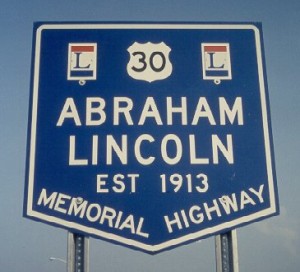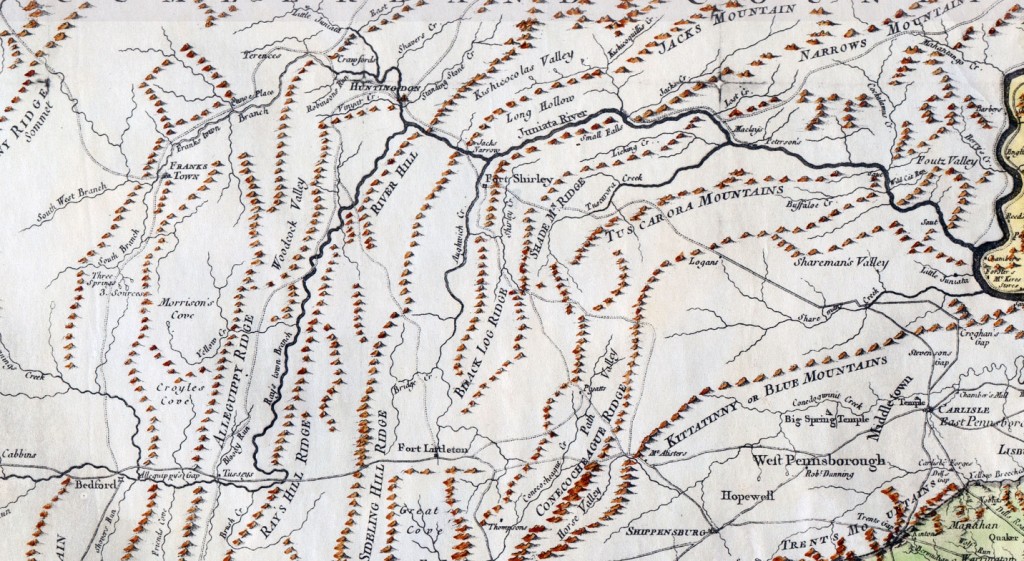“H” is for Highway. “H” is for “History”. And “H” is for … “Pittsburgh”?
I’ve never driven across Pennsylvania. If I ever get the chance, I’d allot ample time to depart the Pennsylvania Turnpike somewhere in the Appalachians. Then I’d pick up US Highway 30, head west toward Pittsburgh, and enjoy a slow unhurried drive.
I’d take in the scenery of the rolling valleys and ridges they call mountains. I’d take in the forests, the scattered small towns and the fertile farmland. And, of course, it would be a drive through history.
Heading west on the Penn Turnpike, just after Fort Littleton — and after descending Sideling Hill Ridge — there’s a break in the next ridge. That’s Ray’s Hill Ridge. It’s there that the Turnpike (I-76) is joined by I-70. That’s your cue to exit. It’s a tricky double-looper getting onto US 30 near Breezewood – so follow the signs carefully.
Get on US 30 in time to see the Raystown Branch[1] of the Juniata River. From here, this branch turns north to feed the Susquehanna, which empties into the Chesapeake. But we’re headed to Pittsburgh, where the mighty Ohio River is formed at the great river confluence. That’s a whole different watershed (Mississippi vs. Atlantic), so we’ve got more hills to climb. [7]
Safely off the interstates and turnpikes, we’re headed on the highway through history, and trying to nail down that elusive H.
Just 40 miles through the trees and gentle Appalachian hills and we’re at the Flight 93 National Memorial. Established and maintained by the US National Park Service at the crash site of United Airlines Flight 93, it is a tribute to the passengers who helped save the US Capitol, in Washington, DC, from attack on 9/11/2001. It functions not only as a memorial, but also as a classroom that honors those killed by terrorism on that day, the bravery shown on that day, and America’s enduring spirit.
Going back a bit further in time: this stretch of road coincides with part of the original Lincoln Highway, America’s first coast-to-coast motorway. Conceived in the Edwardian/Pre-war Era, in 1912, with construction beginning a year later, the Lincoln Highway was one of the first really grand endeavors to link America’s appetite for free-spirited adventure with the automobile.
Coming sooner in our trip along US 30, but farther back in time, and we’re passing through Bedford. Bedford is named for Fort Bedford. A bit further along the highway, and soon after the Flight 93 Memorial, we’ll cross a ridge and drop into the Ohio/Mississippi basin. Soon, we’ll come to the small borough of Ligonier, which is named for Fort Ligonier. [4]
To tell the story of these forts — Fort Bedford and Fort Ligonier — we’ll go back a bit further, to 1707. But first, let’s stop at 1762, at Jean Bonnet Tavern, an establishment providing lodging, food and beverages to travelers across Pennsylvania since 1762.[2] Located on US 30 just past Bedford on the way to Shellsburg, they’ll nourish you with fine local and historic cuisine – and impress you with an impressive selection of refreshments, including beers and ciders (if internet reviews are to be believed).
To figure out why the Tavern is there, we’ll have to continue back to 1707, before returning.
1707: That’s just at the same time as the formal union of Scotland and England into a single country: Great Britain. John Forbes was born that year, across the Firth of Forth from Edinburgh, Scotland, in the lovely peninsula called “the Kingdom of Fife” and “the Birthplace of Golf.” He was raised there, at the family estate, as the son of an army officer.
John became a military man himself. After a distinguished career he was appointed a Brigadier General by Prime Minister William Pitt (the Elder). This was during the French and Indian War [3] (1756-63), which was the largest fight for control of North America between England and France. In 1758 Forbes was appointed the task of taking the French stronghold, far across Pennsylvania — across the Appalachians — at the head of the Ohio River: Fort Duquesne.
Forbes was a very practical and straightforward man. The path from British-controlled Philadelphia – across the mountains – was difficult indeed.
Forbes chose this very route we would travel for his road. He chose it for its gentler elevation changes and few river crossings. It would be called “Forbes Road.” Fearing loss of communication and supply lines, Forbes had strongholds built along Forbes Road, among them Fort Bedford and Fort Ligonier. So well-chosen for location – water supply and good transportation links through the mountains — that they became the boroughs [4] of Bedford and Ligonier along our Highway 30 path.
Forbes grew unhealthy as he led his road-building army across Pennsylvania through the summer of 1758. By the time they reached Fort Duquesne he was very ill indeed. His bravery and resolve through the illness helped inspire his men.
The British initial attempt to take the fort was beaten back by the French and their Amerindian allies. However, it soon became apparent that Forbes had far superior numbers and a solid supply line: he could lay siege to the fort indefinitely.
Consequently the French lost their Indian allies and, subsequently, chose to abandon Fort Duquesne without further fight. But not before they had burned it completely.
Forbes claimed the strategic location for the British crown. He had the fort rebuilt and named for the man who had commissioned him: Fort Pitt.
He named the settlement likewise after Pitt, and sent him a letter informing him so. In the letter he spelled it in his native Scottish style: Pittsbourgh. No doubt intending it to be pronounced like a Scotsman would pronounce Edinburgh: Edd-inn-burr-ah.
Forbes, now gravely ill, returned almost immediately to Philadelphia. Unfortunately, he died only a few months later, aged only 51. [5] Forbes Avenue in Pittsburgh was named after him, as was the baseball stadium Forbes Field, which stood from 1909-1971.
When the city was officially chartered by the state of Pennsylvania in 1816, citing Forbes’ letter to Pitt, the charter read Pittsburgh, with an “H”.
Well that explains how the “H” got in Pittsburgh, but that’s not the rest of the story. An earlier version of the Domestic Names Committee of the US Board on Geographic Names (see footnote 1) detested the “H” in “-burg” named cities.
In 1890 the H was excised, and – officially anyhow, at the federal level – the name was Pittsburg, without the H. Oh those Germans must’ve been happy.
Oddly, beginning in 1817, when the official copies of the charter were made, the printers assumed there had been an error, and spelled it without the “H.” The Board on Names’ 1890 decision cited these copies containing the error as justification for dropping the “H.”
Strong-willed as most Pittsburghers and many Pennsylvanians are, they would not change the spelling. They put up quite a fuss. All city and some state documents and correspondence continued to proudly use the “H.” So did Pittsburgh University and the local press. The Pirates, however, a major league baseball team, used the official spelling, sans H. (see photo [6]).
Well, the feud persisted, until , in 1911 (in the Edwardian/Pre-war Era) – after a reorganization of the US Board on Geographic Names – the government agency in charge of names finally relented.
Was it because of the obstinacy of Pittsburghers? Or was it because they’d been made aware of the spelling in the true copy of the original charter? Who can to say? Regardless, the name was officially Pittsburgh, with the H, once again.
I guess it pays to be consistent (or is that persistent?) when arguing about silent letters.
Happy and Safe Travels
Joe Girard © 2015
[1] – Raystown Branch: The Domestic Names Committee of the US Board on Geographic Names does not like possessive apostrophes. This river was called the Ray’s Town Branch until 1890. Similarly, Ray’s Hill Ridge is now: Rays Hill Ridge. Hence: Pikes Peak, not Pike’s Peak, etc. Five such names have been permitted, including, most famously, Martha’s Vineyard.
[2] Jean Bonnet Tavern: http://www.jeanbonnettavern.com/
[3] French and Indian War, 1756-63: most non-American and non-British commonwealth historians call this The Seven Years’ War.
[4] Boroughs in Pennsylvania are akin to Towns in many other states. Usually much smaller than cities, population is usually from a few hundred to several thousand.
[5] John Forbes
Forbes Trail: http://www.warforempire.org/visit/forbes_trail.aspx
Biographical notes: http://www.undiscoveredscotland.co.uk/usbiography/f/johnforbes.html
[6] A very rare baseball card indeed. A whole story behind it. A mint condition Wagner card like this recently sold for $2.8 Million.
[7] Continental Divides of North America. See the Eastern Divide in western Pennsylvania
Old Maps





